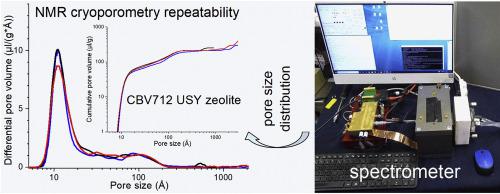Microporous and Mesoporous Materials ( IF 4.8 ) Pub Date : 2020-06-29 , DOI: 10.1016/j.micromeso.2020.110404 J. Beau W. Webber , Vincent Livadaris , Andrey S. Andreev

|
We report on the application of the NMR cryoporometry (C NMR) technique to probe the micro- and mesopore size distributions in industrially important USY zeolites (Si/Al ratio of 30, 15, and 6). The technique provides the clues to small mesopore structure range (20–110 Å) created by various postsynthesis treatments of zeolites like ion exchange, steaming, acid leaching and mesoporization. C NMR is compared with the conventional Barrett-Joyner-Halenda (BJH) model to construct the pore size distributions. Both methods account for the mesopore volume, and under some approximations the micropore volume. The C NMR approach has been effectively applied to the study of extruded samples. It is concluded that the significant increase of mesoporosity in extrudates is more due to the binder possessing this porosity range. The effect of mesoporization when comparing the extrudates of parent sample and mesoporized zeolites is less pronounce than in the initial porous material as observed by both C NMR and BJH pore size distributions. Therefore, an important transport amelioration in extrudates is observed apparently due to alumina playing a role of binder.
中文翻译:

核磁共振超低温法探测USY沸石介孔率
我们报道了NMR低温法(C NMR)技术在探测重要的USY沸石(Si / Al比为30、15和6)中的微孔和中孔尺寸分布方面的应用。该技术为各种介孔后沸石的离子交换,汽蒸,酸浸和介孔作用的后合成处理提供了小介孔结构范围(20-110Å)的线索。将13 C NMR与常规的Barrett-Joyner-Halenda(BJH)模型进行比较,以构建孔径分布。两种方法都考虑了中孔体积,并且在某种程度上近似了微孔体积。C NMR方法已有效地应用于挤压样品的研究。结论是挤出物中孔率的显着增加更多是由于粘合剂具有该孔隙率范围。如通过C NMR和BJH孔径分布所观察到的,当比较母体样品和中孔沸石的挤出物时,中孔作用的影响不如初始多孔材料明显。因此,显然由于氧化铝起粘合剂的作用,挤出物中的重要运输改善。











































 京公网安备 11010802027423号
京公网安备 11010802027423号